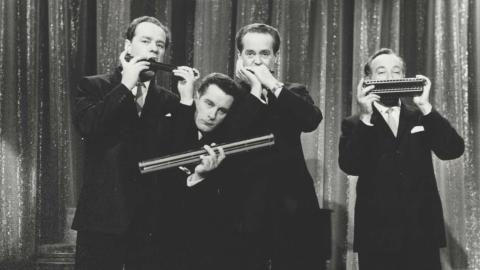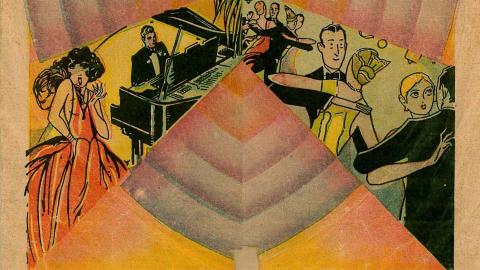

Pathé's vertical groove
We recently acquired a small collection of seven rare Pathé vertical-cut disc records featuring recordings by Melbourne-born music hall star Billy Williams – one of the most popular and most widely recorded entertainers of his era.
Discs unlike any others
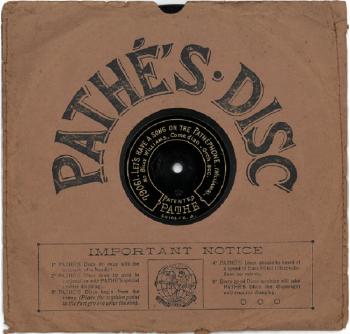
Pathé Records was established by brothers Charles and Émile Pathé in Paris in the 1890s, initially selling Edison and Columbia phonographs and accompanying cylinder records. The brothers were soon designing and selling their own phonographs, and producing cylinder records.
In 1905 the Pathé brothers began producing disc records radically different from their competitors. Whereas other discs from the period were produced as lateral cut recordings, the Pathé discs were recorded vertically in the groove, and required a special ball-shaped ‘sapphire stylus’ to play them.
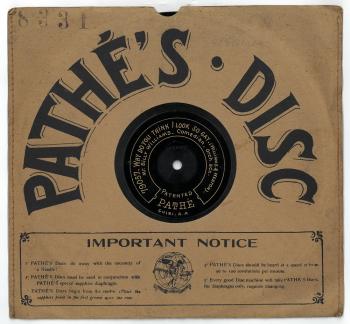
This was a key marketing difference to their rivals, as it meant there was no need to change the needle after each playback. Attachments were produced to allow Pathé phonographs to play laterally-cut records, and to allow standard phonographs to play Pathé discs.
The discs produced by Pathé from 1906-1915 rotated at 90 rpm, rather than the more common 75 to 80 rpm, and they played from the inside out. From 1915 to the end of production Pathé brought their discs into line with those of other manufacturers, so they rotated at 80 rpm and played from the outside inwards. This change also saw their labels, which till that point had been engraved lines filled with white pigment, change to the more common paper labels.
Australian recording star
The records we acquired contain songs by one of the earliest Australian-born recorded music stars, Billy Williams.
Born Richard Isaac Banks in Melbourne, Billy Williams (3 March 1878 – 13 March 1915) changed his name after leaving Australia in December 1899 to pursue an entertainment career in England.
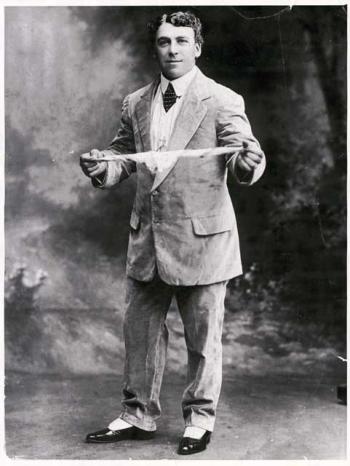
Williams initially performed as an understudy for a clown at the Hippodrome, before touring with the Moss and Stoll pantomime circuit performing a wide range of comedic songs. Early on in his English career, he began wearing a velvet suit and became known as the ‘Man in the velvet suit’. In 1906 Williams made his first recordings, spurred on by fellow Australian musical hall star Florrie Forde.
Williams recorded prolifically on cylinder and disc, with over 500 recordings produced for a range of record companies, including Edison, Zonophone, Homophone, Rexophone, Universal, Coliseum, Pathé and more! Many of his recorded songs were penned by lyricist Fred Godfrey.

In 1910, he returned to Australia for an extended tour with Harry Rickards’ Tivoli circuit, receiving top billing and rave reviews. In 1912, back in England and at the height of his performance career, he appeared in the first Royal Command Performance of that year to glowing reviews.
Williams' success was unfortunately short-lived; he became ill in late 1914 and died in Hove near Brighton in March 1915, at the age of 37.
In 1989 the NFSA released a selection of Williams’ recordings on CD; and in 2016, Williams’ song, ‘When Father Papered the Parlour’ was named one of the NFSA’s Sounds of Australia.
New in our collection
These are the Pathé discs which are now preserved by the NFSA:
7" discs
Since Poor Father Joined The Territorials / My Girl From London (NFSA title 1499469)
Let's Have A Song On The Pathephone / St. Kilda, Australian Song (NFSA title 1499490)
Don't Go Out With Him To-Night / My Sweeta Rosetta (NFSA title 1499526)
Why Do You Think I Look So Gay / I've Found Kelly (NFSA title 1499482)
I'll Meet You One Dark Night / The Colliers (NFSA title 1499402)
Postcards / Put A Bit Of Powder On It Father (NFSA title 1499463)
12" disc
Wait Till I'm As Old As Father / Where Does Daddy Go (NFSA title 1499546)
The National Film and Sound Archive of Australia acknowledges Australia’s Aboriginal and Torres Strait Islander peoples as the Traditional Custodians of the land on which we work and live and gives respect to their Elders both past and present.
